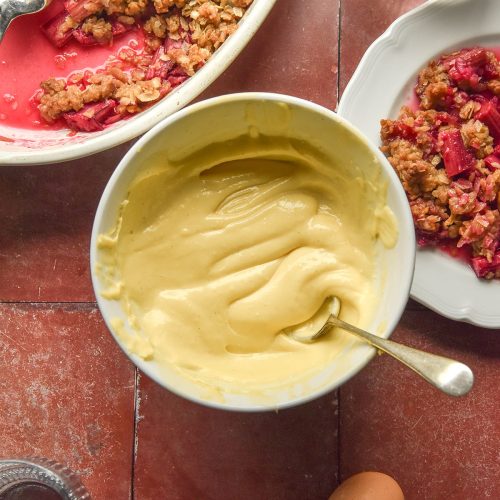
Lactose free custard
Lactose free, gluten free, corn free option
Ingredients
- 30 g cornstarch (see notes)
- 30-60 g caster sugar (see notes)
- 4 extra large egg yolks or 2 whole eggs
- 250 ml lactose free thickened cream (see notes)
- 250 ml lactose free full fat milk (see notes)
- 1 tsp vanilla extract
Instructions
- Whisk together the cornstarch and caster sugar in a medium mixing bowl. Ensuring the cornstarch is completely whisked into the sugar will ensure you don’t have lumps of cornstarch in your custard. This is particularly important with the whole egg custard, as the cornstarch doesn’t dissolve into the egg whites the way it does with egg yolks.
- Whisk in 4 egg yolks or 2 whole eggs. The egg yolk version is thinner, pourable and has a slightly more golden hue. The whole egg version is thicker and has more of a thinner but spoonable pudding consistency.
- Place a tea towel on the bench, get your whisk ready and set aside a medium/large pouring or measuring jug.
- Place the cream and milk in a medium saucepan over a low-medium heat. Heat the mixture, whisking intermittently, until it is hot to the touch but not boiling or simmering.
- Turn the heat off and ladle half of the hot dairy mixture into your pouring jug.
- Place the bowl of egg mix on the tea towel (to stop it moving) and whisk the mixture as you very slowly drizzle in the hot dairy mixture.
- Continue drizzling and whisking until you have used all the dairy. Tempering the eggs like this brings up them to a warm temperature gradually so that they don’t split and you get a lovely smooth custard.
- Decant the mixture back into the empty pouring jug. Return to the stove and repeat the process – drizzle your egg and dairy mixture into your saucepan with the remaining dairy as you whisk. Once all of your mixture is back in the saucepan, turn the heat to low-medium.
- Continue to whisk and cook for about 5-10 minutes. The length of time will depend on the eggs you use - egg yolk custard takes longer to thicken and whole egg custard is quicker. Make sure to get the corners of your pot, as custard can settle and overcook.
- As you mix, the custard should thicken and coat the back of a spoon easily. If you're making the whole egg version, the custard should thicken to a point where the whisk leaves tracks in the surface. If you're making the egg yolk version, it will be more of a liquid consistency but should still feel tangibly thickened under the whisk.
- Continue to cook on a low heat until your custard thickens to nearly your desired consistency. It continues to cook and thicken as it cools, so If in doubt, take it off the heat. You don’t want to overcook the eggs and curdle your custard.
- Cover your custard with a film of cling wrap once it has finished cooking. This will prevent it from forming a skin. If your custard does form a skin, you can simply whisk it in (although you might get a few little lumps). You can sieve the custard to remove the lumps if you want to.
Notes
- I have found the best substitute for cornstarch to be potato starch.
- The colour of your custard depends on the colour of your egg yolks. Egg yolks with a deep orange hue will create a brighter custard colour.
- 30g of caster sugar creates a subtly sweet custard which is perfect for me. I know that tastes for sweetness differ globally, which is why the range for sugar is there.
- Keep in mind that lactose free dairy tastes sweeter than regular dairy. This is because the converted lactose tastes sweet.
- If you are using this recipe to make Ninja Creami ice cream, I recommend the 60g sugar option.
- Egg yolks create a thinner, more pourable custard. Whole eggs create a thicker, more spoonable and pudding like custard.
- Whole egg custard thickens more quickly than egg yolk custard. If you are new to making custard, I recommend whole egg custard. The visual cues are easier to spot and the thickening is a lot more tangible.
- I have a dairy free custard recipe here.
- If you are looking for a tart filling, I recommend using the crème patissiere in my cookbook Intolerance-Friendly Kitchen. It is designed for that purpose and there is a vegan version as well.
- Lactose free thickened cream and milk are available at supermarkets around Australia. If you are not based in Australia, use my recipe for homemade lactose free cream here (obviously don’t whip it – stop at step 2) and my lactose free milk recipe here.
Tried this recipe?Let us know how it was!